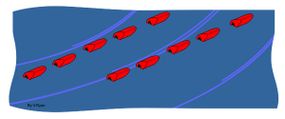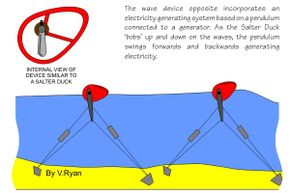How Salter's Duck Works
Salter's Duck is just one of many concepts for a wave energy converter (WEC), which can potentially convert wave power to usable energy. But in the 1970s, when alternative energy was gaining a lot of hype, it was the most exciting possibility. Since then, some companies have successfully implemented other WECs, like the farm of Pelamis devices (consisting of a series of floating cylindrical devices that drive generators) off Portugal. The Pelamis was even designed by Salter's former students [source: Economist]. But compared to Salter's Duck, these modern devices are relatively inefficient. (For more information on wave energy devices, read How Wave Energy Works)
The Duck falls under a class of WECs known as terminators. Terminators are oriented perpendicular to the direction of the wave. And, this is appropriate, as the Duck is basically the Schwarzenegger of WECs, destroying the waves it faces, leaving a calmer sea on the other side [source: Stuart].
Advertisement
The Duck itself is shaped like a teardrop, and many of these "teardrops" attach to a long spine to make up the whole Salter's system [source: Cavendish]. The nose of the teardrop faces incoming waves and bobs as they pass. Essentially, this involves a transfer, or "capture," of the wave's energy. In theory, this bobbing action would capture as much as 90 percent of the wave's massive energy, and uses that energy to keep pistons running. The pistons in turn pressurize hydraulic oil. When pressurized enough, the oil enters a hydraulic motor, which generates electricity [source: Stuart]. The system would theoretically use 90 percent of the captured energy. This high efficiency makes the Duck the Holy Grail of WECs.

Salter and his team tested the Duck in special tanks, using a wave maker. Before they were able to test the Duck at sea, they estimated that they were close to a Duck that would produce electricity at a cost cheap enough to compete with other energy sources.
After the embargo ended, the interest in renewable energy didn't fade completely. Salter and his group had to compete for grants against other renewable energies, such as nuclear power. In the end, nuclear power seemed more economically feasible to the panel that awarded grants. Salter's group lost funding in the early 1980s, before it got a chance to test the mechanism in the ocean, which would have cost a pretty penny. He and others still contend that members of the panel were biased toward nuclear energy [source: Stuart]. Some say the nuclear proponents exaggerated the costs of the electricity the Duck would produce [source: GreenLeft].
Had Salter's group continued to secure funding, perhaps the Duck would be implemented today, powering a portion of the world's energy. It's hard to say whether the Duck alone could have solved the oil crisis, however. When it comes to renewable energy, getting the price low enough to compete with fossil fuels and nuclear power is really what determines its success. And, because it never got to sea for much-needed testing, we can't say with certainty how cheap its electricity would have been.
Also, even if the Duck succeeded, some argue that only areas of the world hit with powerful waves could use it. So, although it might solve an oil crisis in Scotland, which is pummeled with large waves on its coasts, it might not solve it in the U.S., where only a limited amount of coastline receives powerful waves.
On the next page, you'll find links to more articles on alternative energy and the ocean.
Related HowStuffWorks Articles
More Great Links
Sources
- AP. "Push mowers gain value as gas prices rise." Chicago Sun-Times. June 22, 2008. (July 3, 2008) http://www.suntimes.com/business/1017807,CST-FIN-pushmower21WEB.article
- Cavendish, Marshall. "How it Works: Science and Technology." Michael Cavendish, 2003. (July 3, 2008.) http://books.google.com/books?id=fQ5vOMYlKRIC&pg=PA2675
- Economist. "The coming wave." Economist.com. June 5th, 2008. (July 3, 2008) http://www.economist.com/science/tq/displaystory.cfm?story_id=11482565
- GreenLeft. "The untimely death of Salter's Duck." GreenLeft Online. July 29, 1992. (July 3, 2008) http://www.greenleft.org.au/1992/64/2832
- Halber, Deborah. "Seventies oil crisis was a 'perfect storm' for U.S." MIT Tech Talk. April 4, 2007. (July 3, 2008) http://web.mit.edu/newsoffice/2007/techtalk51-22.pdf
- Stuart, Nathan. "Wave master." Engineer. April 10, 2007. (July 3, 2008.) http://www.theengineer.co.uk/Articles/299034/Wave+master.htm
